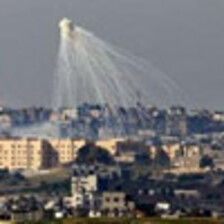The Electronic Intifada 12 January 2009
RAMALLAH (IPS) - “There is no doubt that Israel is using phosphorous bombs over Gaza. Israel is flagrantly violating the Fourth Geneva Convention,” says Raji Sourani, head of the Palestinian Centre for Human Rights (PCHR) in Gaza.
“This is not the first time we have documented Israel using this kind of prohibited weapon against Gaza’s civilian population,” Sourani told IPS on phone from Gaza.
Human Rights Watch (HRW) confirmed Sourani’s assessment in a statement it released on Friday. Its researchers said they had seen “multiple air-bursts of artillery-fired white phosphorous over Gaza City.”
“I’ve been on the border for the last few days watching the Israeli artillery firing white phosphorus shells into refugee camps,” Marc Garlasco, senior military analyst at HRW told France TV channel 24.
Ann Sophie Bonefeld from the International Committee of the Red Cross (ICRC) in Jerusalem was more cautious. “We haven’t been able to confirm if Israel is using phosphorous bombs in Gaza,” she told IPS.
Chiara Stefanini, Health and Human Rights Officer of the World Health Organization (WHO) in Jerusalem told IPS, “We have no evidence of phosphorous being used at this point in time. It is still too early to comment.”
Terrifying pictures released by Israeli military planes of white clouds blanketing the skies of Gaza have filled the screens of Al-Jazeera television every night.
Israeli government spokesman Mark Regev was unable to tell Al-Jazeera whether the Israeli army were using this controversial weapon, and referred the network to Israeli army spokeswoman Major Avital Leibovitch during an interview Sunday.
“We don’t discuss what weapons we use,” Leibovitch told Al-Jazeera. “But I can assure you we do not use any weapons that are prohibited by international law. There are other nations that use phosphorous bombs, and we have the right not to comment on this,” she added.
Britain and the United States used phosphorous bombs in Iraq, particularly during the Fallujah campaign.
The Geneva Treaty of 1980 stipulates that white phosphorus should not be used as a weapon of war in civilian areas, but there is no blanket ban under international law on its use as a smokescreen or for illumination.
This is not the first time Israel has been accused of using phosphorous bombs in crowded civilian areas in Gaza. Several years ago, doctors in Gaza reported seeing strange wounds on those injured during attacks by Israeli drones, which constantly monitor Gaza from the air.
The wounds consisted of many small holes, often invisible to X-rays, and burns caused by heat so intense that many required amputation because of the extensive burning.
Habas al-Wahid, head of emergency at the Shuhada al-Aqsa Hospital in Gaza City told journalists then that in several cases the legs of the injured were sliced from their bodies “as if a saw was used to cut through the bone.” But there was no evidence of ordinary metal shrapnel in or near the wounds.
At al-Shifa Hospital in Gaza City, spokesman Juma Saka said that on examination of the wounds, the doctors had found a powder on the victims’ bodies and in their internal organs. The microscopic particles turned out to be carbon and tungsten.
“The powder was like microscopic shrapnel, and this is likely what caused the injuries,” Saka said.
Following the claims of the Gaza doctors, an investigating team of Italian journalists from the television channel Rai News 24 took samples of the soil back to Italy.
Carmela Vaccaio, a doctor at the University of Parma, examined the samples and found a high concentration of carbon, as well as copper, aluminum and tungsten, whose presence she considered unusual.
She said in her report that “these findings could be in line with the hypothesis that the weapon in question was a dense inert metal explosive or DIME.”
According to military experts, DIME is a carbon-encased missile that shatters on impact into minuscule splinters. On impact it sets off an explosive that shoots blades of energy-charged, heavy metal tungsten alloy (HMTA) powder, such as cobalt and nickel or iron, with a carbon fiber casing.
This turns to dust on impact, as it loses inertia very quickly due to air resistance, burning and destroying everything within a four-meter range, as opposed to shrapnel which results from the fragmentation of a metal casing.
The metal is designated “inert” because it is not involved in the blast, and not because it is chemically or biologically inert.
Israel was also accused of using phosphorous against civilian targets in Lebanon during the 2006 Israel-Lebanon war. It initially denied the charge, but finally confirmed it following investigation by the same team of Italian journalists, and in the face of overwhelming evidence.
“While the international community might be horrified by the use of phosphorous, this is overlooking the issue that hundreds of half-ton bombs are being dropped on Gaza on civilian targets on a daily basis,” Sourani told IPS.
Gaza’s death toll has risen to over 900, while nearly 4,000 Palestinians have been wounded. The UN reports that half of the deaths are civilian, and half of the civilian casualties are women and children.
One million Gazans are currently living without electricity, and some 750,000 without water, according to UN estimates. Gaza has a population of about 1.5 million.
Thirteen Israelis have been killed, three of them civilian.
Editor’s note: The article originally misidentified Chiara Stefanini as a World Health Organization spokesperson. She is Health and Human Rights Officer of the WHO in Jerusalem, and this article has been updated to reflect that.
All rights reserved, IPS - Inter Press Service (2009). Total or partial publication, retransmission or sale forbidden. Jim Lobe in Washington contributed to this article.
Related Links




